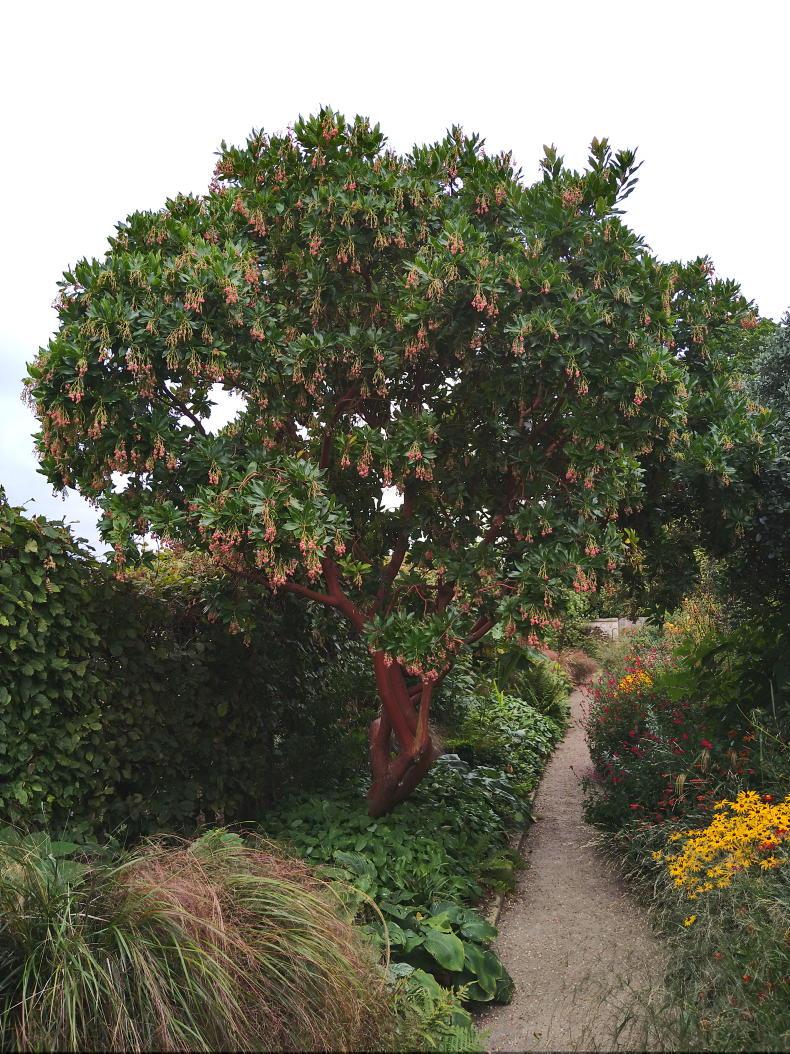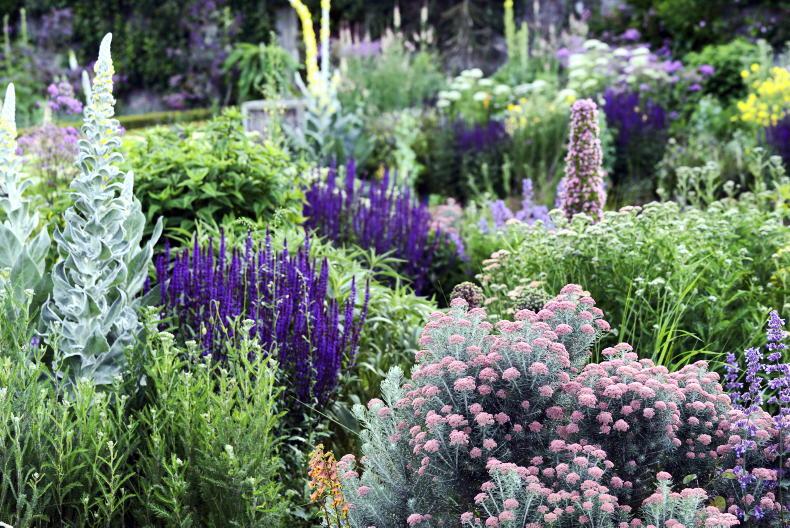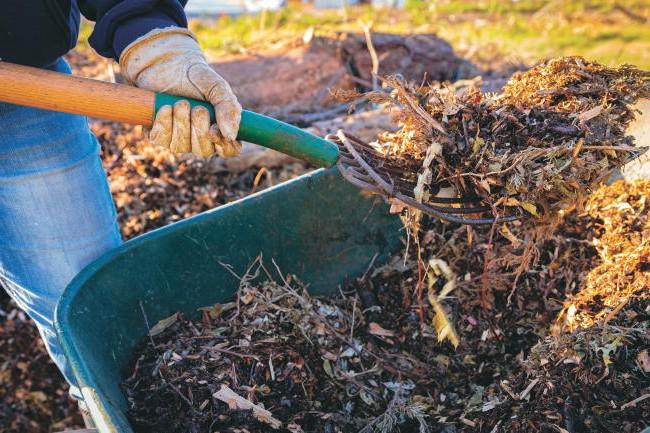The impacts of climate change are posing new problems for Irish gardeners. The lines that delineated our four seasons are continually being blurred. Summer droughts occur with increasing regularity only to be interrupted by unseasonably strong winds and torrential downpours.
Our winters are becoming milder while remaining wet with only occasional cold spells. The future of our climate is uncertain and as gardeners, we need to adapt the way we garden to build resilience in our gardens. Thankfully there are many steps gardeners can take to future-proof the success of our gardens.
Building resilience in our gardens should start from the soil up. When we picture a thriving natural environment, we almost never see bare patches of soil. Yet in many gardens, large patches of naked soil are sprayed or hoed in pursuit of neatness. Conversely, we should aim to fill this bare soil with living plants whose canopy will help retain moisture while the roots will retain nutrients, as well as prevent soil erosion.
Building diverse plant communities that grow in tandem with one another will not only benefit the soil, but will also provide a longer season of interest in our gardens. Layering plants starting with bulbs and subsequently adding a herbaceous layer followed by shrubs, climbers and trees is the simple formula for creating a balanced and resilient garden.

Arbutus 'Marina' in full flower.
However, this is not always practical. Planting a garden with the required planting density to achieve this instantly could be prohibitively expensive.
Equally, there are parts of your garden such as the vegetable patch where you might want to exclusively grow annual plants that require space to develop. In both scenarios, mulching can be a useful tool to prevent leaving your soil bare.
Soil protection strategies
The benefits of applying mulch to the soil surface are numerous. A mulch acts as a buffer zone protecting the soil. This in turn increases water absorption, and decreases the leaching of nutrients while simultaneously reducing weed growth.
A wide range of materials can be used as garden mulches, from garden compost to wood chips, gravel, leaf mould, or even grass clippings. The depth to which a mulch is applied will depend greatly on the material you are using, but generally speaking, a depth of 10cm is ideal for maximum weed suppression. Suppressing weed growth through mulching is key to managing a garden organically. An appropriately timed application of mulch will reduce the weed burden in the garden and is a key substitute for herbicide use.
A compost mulch can also replace the need for the application of synthetic fertilisers which disrupt the naturally occurring ecosystems found in soil.
Mulching the soil around newly planted areas of your garden will greatly aid new plant establishment.
Newly planted trees in particular will benefit greatly from creating weed-free circles around their base and mulching them with woodchip. Typically, these tree circles should range in size from, between 1m and 1.5m in diameter with a thick layer of woodchip applied.
However, it is important to note that the mulch should never be mounded on the stem of a tree or shrub. The act of doing this is commonly referred to as creating “volcanoes”. Persistently creating mulch volcanoes will cause more harm than good, leading to rotting and decay developing at the base of the tree.
Even the seeds we chose to grow in our soil have the ability to increase resilience in our gardens. Every time a seed crop is grown it adapts unique characteristics that are a direct result of its interaction with the environment it grew in. This is referred to as the seeds phenotype.
Gardeners may often notice that seeds they save from their own garden plants appear to grow stronger than those bought from a seed company.

Stipa Ichu in the foreground and pennisetum macrourum in the background
A contributing factor to this is that the phenotype of the seed has adapted to your specific growing environment. Most of the seed we buy from retailers is grown in hotter, sunnier climates where the business of seed production makes the most financial sense. The resulting seed, however, is not always best suited to the unique climate an Irish garden throws at it.
Thankfully, there are Irish seed companies such as Brown Envelope Seeds, Seedie.ie and Irish Seed Savers who exclusively sell Irish-grown seeds. Locally grown seeds will not only be better adapted to Irish growing conditions, but they also have a lower carbon footprint than many imported seeds.
Learning from our hotter neighbours
That is not to say that we should not look for inspiration from beyond Irish shores when it comes to future-proofing our gardens. Although it may not always feel like it, our changing climate has many parallels to a Mediterranean climate.
Mediterranean climates have mild, wet winters and warm to hot dry summers. Remove the word hot from that description and you could just as easily be describing the Irish weather in 2022.
Mediterranean plants have naturally evolved to cope with long periods of drought and occasional torrential downpours, making them ideal candidates for a resilient planting scheme.
Lavender, rosemary, and olive trees are the obvious candidates that spring to mind when considering Mediterranean plants. They may not be the most exciting plants, but they all possess common traits that are important indicators of what makes a resilient plant.

Salvia, Verbascum, Echium, Achelliea, and Ozothamnus in Airfield Estate. \ Richard Murphy
Narrow foliage, often silver in colour and covered in miniature hairs makes these plants drought and wind tolerant. Salvia, Verbascum, Echium, Achelliea, and Ozothamnus are five genera of Mediterranean plants I used heavily in the planting scheme pictured above which was in a windy and drought-prone area in Airfield Estate. Grasses are another excellent plant choice for resilient gardening. We are spoilt by the range of grasses that thrive in our climate but two of my favourites to use are Pennisetum macrourum and the Peruvian feather Grass Stipa Ichu. Both produce impressive inflorescence displays from mid to late summer that last well into the autumn months.
If diversity of plant groups is key to building resilience in your garden, then trees are one of the most important elements to consider. With Ireland’s forestation rates being some of the lowest in the EU every additional tree planted in a garden is a much-needed addition. Trees can provide shelter and stability in the garden and create microclimates for other plants to thrive.
Considering the longevity of trees, choosing which tree to plant is never an easy decision. This decision is becoming ever increasingly difficult with the added uncertainty of what our future climate will be by the time the tree reaches maturity. Already we can see signs of trees struggling to adapt to recent weather patterns.
Last August I witnessed premature leaf drop affect many trees growing in south Dublin as a direct result of the drought conditions experienced in the region. This shortening of the growing season weakens even mature trees, making them more vulnerable to pests and diseases. Shallow-rooting trees such as birch were particularly badly affected.
The rate at which our climate is changing may well be too rapid for many of our native trees to adapt sufficiently. Two native species that may fair out best in our changing climate are the Scots pine Pinus sylvestris and the strawberry tree Arbutus undeo.

Arbutus 'Marina' flower, glossy foliage and red brown bark.
Both trees have good drought tolerance, with the Scots pine in particular well suited to exposed and challenging sites. The strawberry tree is a relatively small tree with a slow growth habit and a long season of interest making it an ideal candidate for a small garden.
The cultivar ‘Marina’ has spectacular peeling red to brown bark and the added bonus of chandelier-like bell flowers in late summer that are followed by the red fruits which persist well into the winter months. Well selected trees have the potential to be the foundation from which you can build your resilient garden around.
The impacts of climate change are posing new problems for Irish gardeners. The lines that delineated our four seasons are continually being blurred. Summer droughts occur with increasing regularity only to be interrupted by unseasonably strong winds and torrential downpours.
Our winters are becoming milder while remaining wet with only occasional cold spells. The future of our climate is uncertain and as gardeners, we need to adapt the way we garden to build resilience in our gardens. Thankfully there are many steps gardeners can take to future-proof the success of our gardens.
Building resilience in our gardens should start from the soil up. When we picture a thriving natural environment, we almost never see bare patches of soil. Yet in many gardens, large patches of naked soil are sprayed or hoed in pursuit of neatness. Conversely, we should aim to fill this bare soil with living plants whose canopy will help retain moisture while the roots will retain nutrients, as well as prevent soil erosion.
Building diverse plant communities that grow in tandem with one another will not only benefit the soil, but will also provide a longer season of interest in our gardens. Layering plants starting with bulbs and subsequently adding a herbaceous layer followed by shrubs, climbers and trees is the simple formula for creating a balanced and resilient garden.

Arbutus 'Marina' in full flower.
However, this is not always practical. Planting a garden with the required planting density to achieve this instantly could be prohibitively expensive.
Equally, there are parts of your garden such as the vegetable patch where you might want to exclusively grow annual plants that require space to develop. In both scenarios, mulching can be a useful tool to prevent leaving your soil bare.
Soil protection strategies
The benefits of applying mulch to the soil surface are numerous. A mulch acts as a buffer zone protecting the soil. This in turn increases water absorption, and decreases the leaching of nutrients while simultaneously reducing weed growth.
A wide range of materials can be used as garden mulches, from garden compost to wood chips, gravel, leaf mould, or even grass clippings. The depth to which a mulch is applied will depend greatly on the material you are using, but generally speaking, a depth of 10cm is ideal for maximum weed suppression. Suppressing weed growth through mulching is key to managing a garden organically. An appropriately timed application of mulch will reduce the weed burden in the garden and is a key substitute for herbicide use.
A compost mulch can also replace the need for the application of synthetic fertilisers which disrupt the naturally occurring ecosystems found in soil.
Mulching the soil around newly planted areas of your garden will greatly aid new plant establishment.
Newly planted trees in particular will benefit greatly from creating weed-free circles around their base and mulching them with woodchip. Typically, these tree circles should range in size from, between 1m and 1.5m in diameter with a thick layer of woodchip applied.
However, it is important to note that the mulch should never be mounded on the stem of a tree or shrub. The act of doing this is commonly referred to as creating “volcanoes”. Persistently creating mulch volcanoes will cause more harm than good, leading to rotting and decay developing at the base of the tree.
Even the seeds we chose to grow in our soil have the ability to increase resilience in our gardens. Every time a seed crop is grown it adapts unique characteristics that are a direct result of its interaction with the environment it grew in. This is referred to as the seeds phenotype.
Gardeners may often notice that seeds they save from their own garden plants appear to grow stronger than those bought from a seed company.

Stipa Ichu in the foreground and pennisetum macrourum in the background
A contributing factor to this is that the phenotype of the seed has adapted to your specific growing environment. Most of the seed we buy from retailers is grown in hotter, sunnier climates where the business of seed production makes the most financial sense. The resulting seed, however, is not always best suited to the unique climate an Irish garden throws at it.
Thankfully, there are Irish seed companies such as Brown Envelope Seeds, Seedie.ie and Irish Seed Savers who exclusively sell Irish-grown seeds. Locally grown seeds will not only be better adapted to Irish growing conditions, but they also have a lower carbon footprint than many imported seeds.
Learning from our hotter neighbours
That is not to say that we should not look for inspiration from beyond Irish shores when it comes to future-proofing our gardens. Although it may not always feel like it, our changing climate has many parallels to a Mediterranean climate.
Mediterranean climates have mild, wet winters and warm to hot dry summers. Remove the word hot from that description and you could just as easily be describing the Irish weather in 2022.
Mediterranean plants have naturally evolved to cope with long periods of drought and occasional torrential downpours, making them ideal candidates for a resilient planting scheme.
Lavender, rosemary, and olive trees are the obvious candidates that spring to mind when considering Mediterranean plants. They may not be the most exciting plants, but they all possess common traits that are important indicators of what makes a resilient plant.

Salvia, Verbascum, Echium, Achelliea, and Ozothamnus in Airfield Estate. \ Richard Murphy
Narrow foliage, often silver in colour and covered in miniature hairs makes these plants drought and wind tolerant. Salvia, Verbascum, Echium, Achelliea, and Ozothamnus are five genera of Mediterranean plants I used heavily in the planting scheme pictured above which was in a windy and drought-prone area in Airfield Estate. Grasses are another excellent plant choice for resilient gardening. We are spoilt by the range of grasses that thrive in our climate but two of my favourites to use are Pennisetum macrourum and the Peruvian feather Grass Stipa Ichu. Both produce impressive inflorescence displays from mid to late summer that last well into the autumn months.
If diversity of plant groups is key to building resilience in your garden, then trees are one of the most important elements to consider. With Ireland’s forestation rates being some of the lowest in the EU every additional tree planted in a garden is a much-needed addition. Trees can provide shelter and stability in the garden and create microclimates for other plants to thrive.
Considering the longevity of trees, choosing which tree to plant is never an easy decision. This decision is becoming ever increasingly difficult with the added uncertainty of what our future climate will be by the time the tree reaches maturity. Already we can see signs of trees struggling to adapt to recent weather patterns.
Last August I witnessed premature leaf drop affect many trees growing in south Dublin as a direct result of the drought conditions experienced in the region. This shortening of the growing season weakens even mature trees, making them more vulnerable to pests and diseases. Shallow-rooting trees such as birch were particularly badly affected.
The rate at which our climate is changing may well be too rapid for many of our native trees to adapt sufficiently. Two native species that may fair out best in our changing climate are the Scots pine Pinus sylvestris and the strawberry tree Arbutus undeo.

Arbutus 'Marina' flower, glossy foliage and red brown bark.
Both trees have good drought tolerance, with the Scots pine in particular well suited to exposed and challenging sites. The strawberry tree is a relatively small tree with a slow growth habit and a long season of interest making it an ideal candidate for a small garden.
The cultivar ‘Marina’ has spectacular peeling red to brown bark and the added bonus of chandelier-like bell flowers in late summer that are followed by the red fruits which persist well into the winter months. Well selected trees have the potential to be the foundation from which you can build your resilient garden around.













SHARING OPTIONS